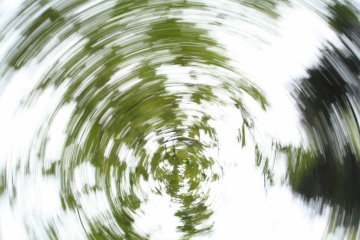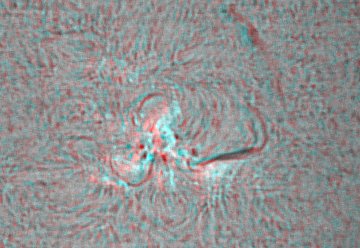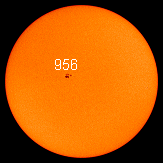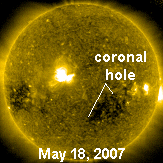 He
already has a tie. This year give Dad something truly heavenly for
Father's Day: SpaceWeather
PHONE. He
already has a tie. This year give Dad something truly heavenly for
Father's Day: SpaceWeather
PHONE.
DON'T MISS THIS: When the
sun sets tonight, go outside and look west. Venus and the crescent
Moon will pop out of the twilight barely 1o apart. It's a spectacular
and unforgettable pairing of the two brightest objects in the night
sky: sky
map.
LEAF TRAILS:
Every night, the stars pirouette in great circles around the north
celestial pole, and this allows photographers to take some nifty
pictures. A camera pointed at the North Star, with the shutter open
for a long exposure, records a dizzying vortex
of star trails.
Star trails are evidence that Earth is spinning. To
illustrate the principle for a children's book she is writing, author
Trudy E. Bell tried something
last weekend that may be completely original. "I mimicked Earth's
spin with a playground merry-go-round, while a leafy tree played
the role of stars." Here is the result:

Photo copyright 2007 Trudy E. Bell. All rights reserved.
She explains how
it was done: "I set my Canon
Digital Rebel to ISO 100, shutter speed slow (best results came
with 1/13th second), and sat in the center of the merry-go-round
while my 12-yr-old neighbor Max kept me spinning."
If you wish to try this yourself, notes Trudy, be
aware that "finding a merry-go-round can be surprisingly difficult.
The one nearest to me was in an old park 25 miles away." And be
careful standing up! "Young Max was chipper and unaffected, but
I felt queasy
for hours after the shoot."
3D SUNSPOT:
Put on your 3D
glasses and take a look at this anaglyph of sunspot 956 created
yesterday by Emiel Veldhuis
of the Netherlands:

It shows a tangle of dark magnetic filaments emerging
from the spot's core. Although sunspot 956 has been quiet for days,
its delta-class magnetic field harbors energy for strong M-class
solar flares. NOAA forecasters estimate a 15% chance of such a flare
during the next 24 hours.
more images: from
Pete Lawrence of Selsey, West Sussex, UK; from
Cai-Uso Wohler of Bispingen, Germany; from
John C McConnell of Maghaberry Northern Ireland; from
Pavol Rapavy of Rimavska Sobota, Slovakia; from
P-M Hedén of Vallentuna, Sweden.
|





